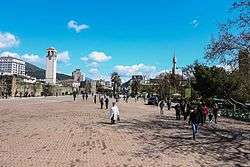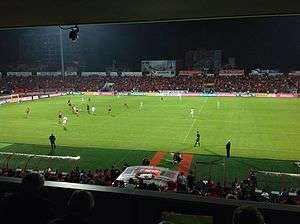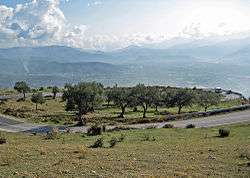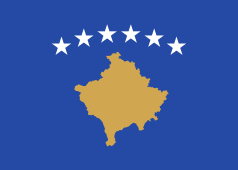Elbasan
| Elbasan | ||
|---|---|---|
| Municipality | ||
 | ||
| ||
 Elbasan | ||
| Coordinates: 41°06′N 20°04′E / 41.100°N 20.067°ECoordinates: 41°06′N 20°04′E / 41.100°N 20.067°E | ||
| Country |
| |
| County | Elbasan | |
| Government | ||
| • Mayor | Qazim Sejdini (SP) | |
| Area | ||
| • Municipality | 872.03 km2 (336.69 sq mi) | |
| • Administrative Unit | 12.90 km2 (4.98 sq mi) | |
| Elevation | 150 m (490 ft) | |
| Population (2015) | ||
| • Municipality | 141,714 | |
| • Municipality density | 160/km2 (420/sq mi) | |
| • Administrative Unit | 120,703 | |
| • Administrative Unit density | 9,400/km2 (24,000/sq mi) | |
| Time zone | CET (UTC+1) | |
| • Summer (DST) | CEST (UTC+2) | |
| Postal Code | 3001-3006 | |
| Area Code | (0)54 | |
| Vehicle registration | AL | |
| Website | Official Website | |
Elbasan (Albanian: Elbasan or Elbasani) is a city and a municipality in Elbasan County, central Albania. One of the largest cities in Albania, it is located on the Shkumbin River in the District of Elbasan and the County of Elbasan. The present municipality was formed at the 2015 local government reform by the merger of the former municipalities Bradashesh, Elbasan, Funarë, Gjergjan, Gjinar, Gracen, Labinot-Fushë, Labinot-Mal, Papër, Shirgjan, Shushicë, Tregan and Zavalinë, that became municipal units. The seat of the municipality is the city Elbasan.[1] The total population is 141,714 (2011 census), in a total area of 872.03 km2.[2] The population of the former municipality at the 2011 census was 78,703.[3]
It was called Neokastron (New Castle) in Greek, Novigrad (new city) in Slavic and Terra Nuova in Italian. The modern name derives from the Turkish il-basan ("the fortress").[4]
History
Ancient and early Byzantine periods
In August 2010 archaeologists discovered two Illyrian graves near the walls of the castle of Elbasan.[5] In the second century BC, a trading post called Mansio Scampa near the site of modern Elbasan developed close to a junction of two branches of an important Roman road, the Via Egnatia, which connected the Adriatic coast with Byzantium. By the third or fourth century AD, this place had grown into a real city protected by a substantial Roman fortress with towers; the fort covered around 300 square meters.[6] This city appears on late antique itineraries like the Tabula Peutingeriana or the Itinerarium Burdigalense as Scampis or Hiscampis.[7]
It took part in the spread of Christianity along the Via, and had a bishop, cathedral and basilicas as early as the fifth century. As a town in a wide river valley it was vulnerable to attacks once the legions were withdrawn but Emperor Justinian made an effort to improve the fortifications. The city survived attacks by the Bulgars and Ostrogoths and was mentioned in the work of Procopius of Cæsarea.
Ottoman period
The site seems to have been abandoned until the Ottoman army built a military camp there, followed by urban reconstruction under Sultan Mehmet II in 1466. Mehmet constructed a massive four-sided castle with a deep moat and three gates. He named it Elbasan, meaning 'conquered country' in Turkish.[8] He had built the castle in order to fight Skanderbeg, due to an ongoing conflict between the Ottomans and Albanians. It became the seat of Sanjak of Elbasan, a centre of Ottoman urban civilisation over the next 445 years. Although Halil Inalcik explains that the Sanjak of Elbasan was established as soon as the fortress of Elbasan was constructed in 1466, based on Tursun Beg's records there is a possibility that Elbasan initially was part of the Sanjak of Ohrid.[9] In 1467 many Christians from Skopje, Ohrid, Serres and Kastoria were forcibly deported to Elbasan.[10] By the end of the 17th century it had 2,000 inhabitants. The fortress was dismantled by Reshit Pasha in 1832. In 1864, the Sanjak of Elbasan became a part of Monastir Vilayet. At the beginning of the 20th century it was estimated that 15,000 people lived in Elbasan.[11]
In 1909, after the Young Turks revolution in Istanbul, an Albanian National Congress was held in Elbasan to study educational and cultural questions. The delegates, all from central and southern Albania, endorsed the decision of the Congress of Monastir, which was held in Monastir (modern Bitola, Republic of Macedonia) to use the Latin alphabet rather than the Arabic script in written Albanian. In Elbasan there were living Albanians, Turkish, Aromunian and Sephardic Jews.
Before the Second World War, Elbasan was a city with a mixture of eastern and medieval buildings, narrow cobbled streets and a large bazaar. There was a clearly defined Muslim settlement within the castle walls, a Vlach district on the outskirts of the city and several fine mosques and Islamic buildings. At the time the population was about 15,000 people.
The English journalist James David Bourchier, then the Balkan correspondent of The Times, records that on a visit in 1911 he saw:
"The population celebrating Bairam in central space: wonderful primitive merry-go round with gypsy minstrels (flute and drum), pushed round by the men with poles; also a cartwheel poised on a tree top; pekhilvans wrestling, mostly refugees from Dibra, thus gaining a precarious livelihood."
Independence of Albania

The very first teachers' training college in Albania, the Shkolla Normale e Elbasanit, was established in Elbasan. During First Balkan War, it was occupied by Serbian troops on 29 November 1912. They withdrew from Elbasan on 25 October 1913 due to United Kingdom and Austria Hungary's ultimatum.
The Muslim majority of Elbasan opposed the installation of Prince Wied in 1914. Elbasan was occupied successively by Serbs, Bulgarians, Austrians and Italians between 1915 and 1918. The Bulgarian army occupied Elbasan on January 29, 1916, during Bulgarian occupation of Albania[12] In March 1916 the army of Austria-Hungary took over control of Elbasan [12] From June 1916 to March 1917 Stanislav Kostka Neumann fought with the Austrian army there and called his war memoirs about the occupation in Elbasan.[13] Industrial development began in the Zogist period when tobacco and alcohol factories were established.
The city was also noted for its good public buildings, advanced educational provisions, public gardens and timber-built shops. There was much wartime damage, which was followed by an intensive programme of industrial development in the Communist period that boosted the city to around 75,000 inhabitants. The culmination of this process was the construction of the huge Steel of the Party (Albanian: Celiku i Partise) metallurgical complex outside the city, in the Shkumbini valley, built with Chinese assistance in the 1970s. It was emphatically called "The Second National Liberation of Albanian" by Enver Hoxha. The cost of the complex in environmental impact was high for the Shkumbin valley.[14]
In 2014, the Albanian government reconstructed former Ruzhdi Bizhuta Stadium. The renovated Elbasan Arena became the home stadium of the Albanian national football team and Albania's de facto stadium meeting FIFA's criteria.
Culture and religion


Elbasan has been occupied by several different groups, including the Serbs, Bulgarians, Austrians and Italians. Elbasan remained a center of Islam in Albania even after the Ottoman occupation. After the 1908 Congress of Monastir (in modern Bitola, Republic of Macedonia) decided to use the Latin alphabet for the written Albanian language, Muslim clerics influenced by the Young Turks held various demonstrations in favor of the Arabic script in Elbasan.
In the middle of the city is found the Saint Mary Orthodox Church. The church was built in 1830 on the foundations of an older church, which had partially burned in 1819. Paintings and frescoes of Onufri, restored by David Selenicasi and Kostadin Shelcani can still be seen. The church has been an important religious and cultural center for the Albanian language. Teodor Haxhifilipi, Kostandin Kristoforidhi, and Aleksandër Xhuvani have served in the church. They are the authors of translations into Albanian of many psalms. The church building served as the first Albanian school of Elbasan in modern times, which opened in 1908.[15]
Other orthodox churches in the Elbasan District include the Mameli church (built in the 17th century), the Saint Nicholas church (Albanian: Shen Kolli) in Shelcan (built in 1554), the Saint Nicholas church in Valesh (built in 1604), the Saints Cosmas and Damian church in Sterstan (built in the 18th century), the Saint Michael (Albanian: Shen Mehilli) church in Shalës (built in the 17th century), the Saint Mary church in Dragot (built in the 18th century), the Saint Nicholas church of Elbasan (17th century), and the Elbasan Saint Athanasius church of Elbasan (built in 1554).
About 7 km away from Elbasan there is an old monastery and orthodox church where notably Saint Jovan Vladimir was buried until 1995 when his remains were transferred to the Orthodox Cathedral in Tirana, being brought back to the monastery only for his feast days.[16]
Elbasan is home to the National Autocephalous Albanian Church (Albanian: Kisha Autoqefale Kombetare), a relatively new Orthodox Autocephalous church that split from the Albanian Orthodox Church in 1995. Father Nikolle Marku is the leader of the new denomination.[17]
Elbasan is also home to a Catholic church.
Elbasan has four museums:[18]
- Ethnographic Museum (1982) held in an 18th-century building
- “Kostandin Kristoforidhi” house (started as a museum in 1978)
- Shkolla Normale Museum
- War Museum

Elbasan is the home to the Summer Day festivities, a pagan feast celebrating the end of winter and the coming of summer. Ballokume, cookies made from butter and corn wheat is the traditional dish served in this day. Since 2004, it has become a national holiday being celebrated in Tirana on a Monday in mid-March.
Economy
Industrial development began during the Zog regime with the production of tobacco and alcoholic beverages, and culminated during the communist regime. The city gained prominence after the Chinese built a steel mill in 1974. There were also other industries operating in the city during the communist regime.
Notable people
- Sedefkar Mehmed Agha, 16th century architect
- Dervish bej Biçaku, signatory of the Albanian Declaration of Independence
- Miriam Cani, singer
- Shefqet bej Daiu, signatory of the Albanian Declaration of Independence
- Aqif Pashë Elbasani (Aqif Biçakçiu), proclaimed the independence of the Elbasan November 25, 1912, Interior Minister of Albania in 1914, President of the provisional government (with the support of Austria) in 1916 and a member of Parliament in 1926.
- Ibrahim Biçakçiu, former Prime Minister of Albania
- Dritan Kiçi, writer, painter, publisher, TV producer, and philanthropist
- Qemal bej Karaosmani, signatory of the Albanian Declaration of Independence
- Kostandin Kristoforidhi, translator in Albanian of the New Testament
- Lef Nosi, signatory of the Albanian Declaration of Independence
- Dhimitër Shuteriqi, writer and critic
Twin towns - sister cities
Elbasan is twinned with:
-
 Novi Ligure, Italy
Novi Ligure, Italy -
 Turku, Finland
Turku, Finland -
 Treviso, Italy
Treviso, Italy -
 Mitrovica, Kosovo
Mitrovica, Kosovo -
 Newcastle upon Tyne, United Kingdom
Newcastle upon Tyne, United Kingdom -
 Iquitos, Peru
Iquitos, Peru
See also
- Clouds of Smoke (documentary film)
- Elbasan script
- History of Albania
- List of cities in Albania
- Elbasan Arena
- Shebenik-Jabllanice National Park
References
- ↑ Law nr. 115/2014
- ↑ Interactive map administrative territorial reform
- ↑ 2011 census results
- ↑ Robert Elsie: Historical dictionary of Albania. Books.google.gr. 2010-03-19. Retrieved 2013-08-10.
- ↑ Popja, Fatmir. "Elbasan, zbulohen dy varre ilire në muret e kalasë". Retrieved 9 August 2010.
- ↑ Gloyer, Gillian (2012). Albania. Chalfont St Peter: Bradt Travel Guides. p. 107. ISBN 9781841623870. Retrieved 20 October 2013.
- ↑ Hammond, N.G.L. (1974). "The Western Part of the via Egnatia". The Journal of Roman Studies. Society for the Promotion of Roman Studies. 64: 188. doi:10.2307/299268. JSTOR 299268.
- ↑ http://www.blue-albania.com/GeneralInfo14-ELBASANI.htm
- ↑ Kiel, Machiel (1990), Ottoman architecture in Albania, 1385-1912, Istanbul: Research Centre for Islamic History, Art and Culture, p. 39, ISBN 978-92-9063-330-3, retrieved 9 January 2012,
...states that Elbasan became a sandjak capital right after 1466 but the usually well informed Tursun Beg noted for 1466: "The sultan attached this fortress of Elbasan to the Sancak of Ohrid and returned to Edirne..."
- ↑ Shukarova, Aneta; Mitko B. Panov; Dragi Georgiev; Krste Bitovski; Academician Ivan Katardžiev; Vanche Stojchev; Novica Veljanovski; Todor Chepreganov (2008), Todor Chepreganov, ed., History of the Macedonian People, Skopje: Institute of National History, p. 133, ISBN 9989-159-24-6, OCLC 276645834, retrieved 26 December 2011,
At the same time or nearly in 1467 the citizens from Skopje, ...were expa-triated to the Albanian city of Konjuh (Elbasan), which was constructedas a fortress to help the fighting against Skender-Bey. ... these Christians from Skopje as Elbasan’s citizens appeared other families from Ohrid, Kastoria and Serres that were compulsorily moved into this city..
- ↑ Raza, Moonis (1906). Geographical Dictionary Of The World In The Early 20th Century. Logos Press. p. 588. Retrieved 31 July 2011.
...Pop estimated at 15,000
- 1 2 Pearson, Owen (2004). Albania and King Zog: independence, republic and monarchy 1908-1939. I.B.Tauris. p. 103. ISBN 978-1-84511-013-0. Retrieved January 11, 2011.
January 29th; ... Bulgarian troops had also crossed Albanian frontier, and Elbassan in central Albania was occupied by a company of the 23rd Bulgarian Infantry Regiment under Captain Serafimov
- ↑ (Czech) S.K. Neumann: Elbasan, družstevní nakladatelství "Kniha", knihovna socialistické kultury, svazek III., Praha 1922
- ↑ Rukaj, Marjola. "Elbasan, Elbasan, the polluted city". Retrieved 20 October 2013.
- ↑ "From the Saint Mary website". Kishaautoqefale.webs.com. Retrieved 2013-08-10.
- ↑ Milosavljević, Presbyter Čedomir (September 22, 2007). Св. Јован Владимир (in Serbian). Pravoslavna Crkvena Opština Barska. Retrieved 2008-01-03.
- ↑ "Church's official website". Kishaautoqefale.webs.com. Retrieved 2013-08-10.
- ↑ "Municipality website". Elbasani.gov.al. Retrieved 2013-08-10.
"Elbasan Deserves More: Strategic Development Plan of the City 2010-2020"
External links
| Wikivoyage has a travel guide for Elbasan. |
| Wikimedia Commons has media related to Elbasan. |
- Official website (Albanian)
- oraret e Elbasanit, Elbasan Timetables
- Elbasan travel guide
- News about Elbasan (Albanian)



